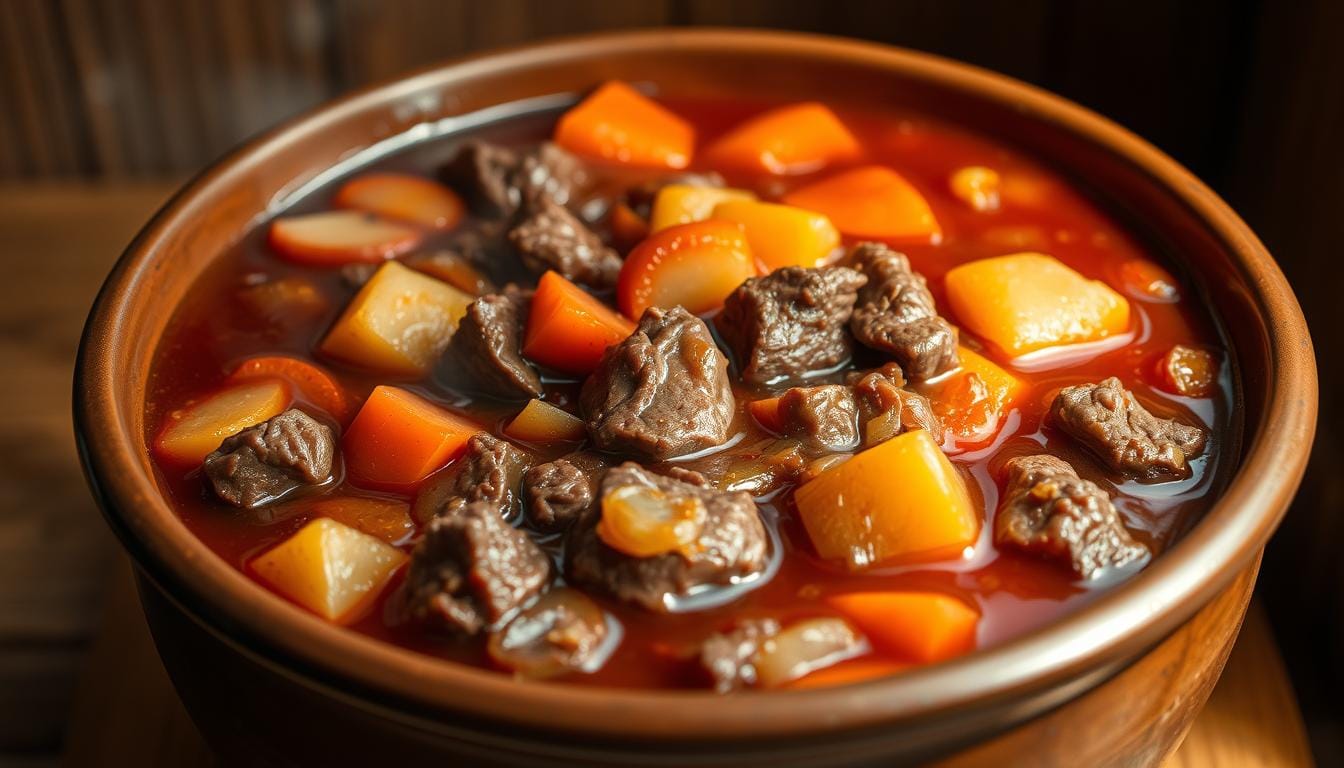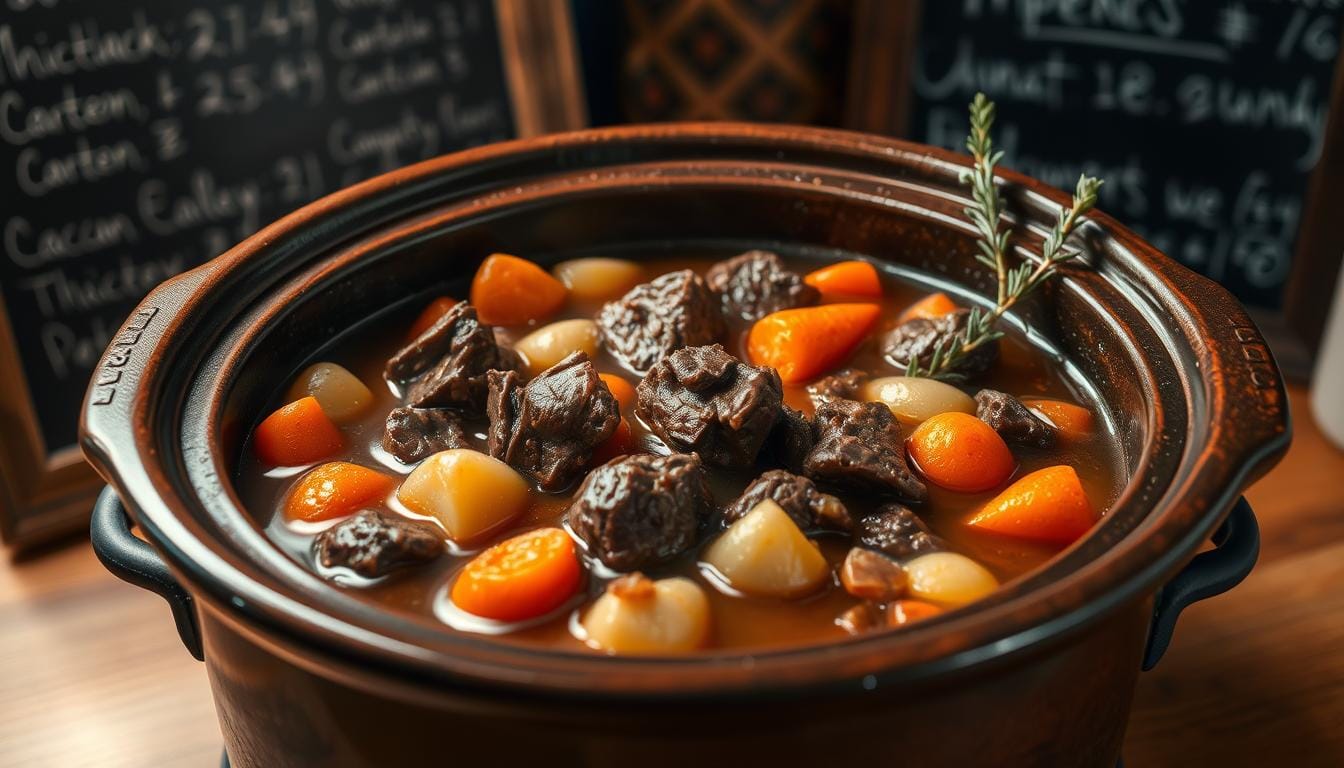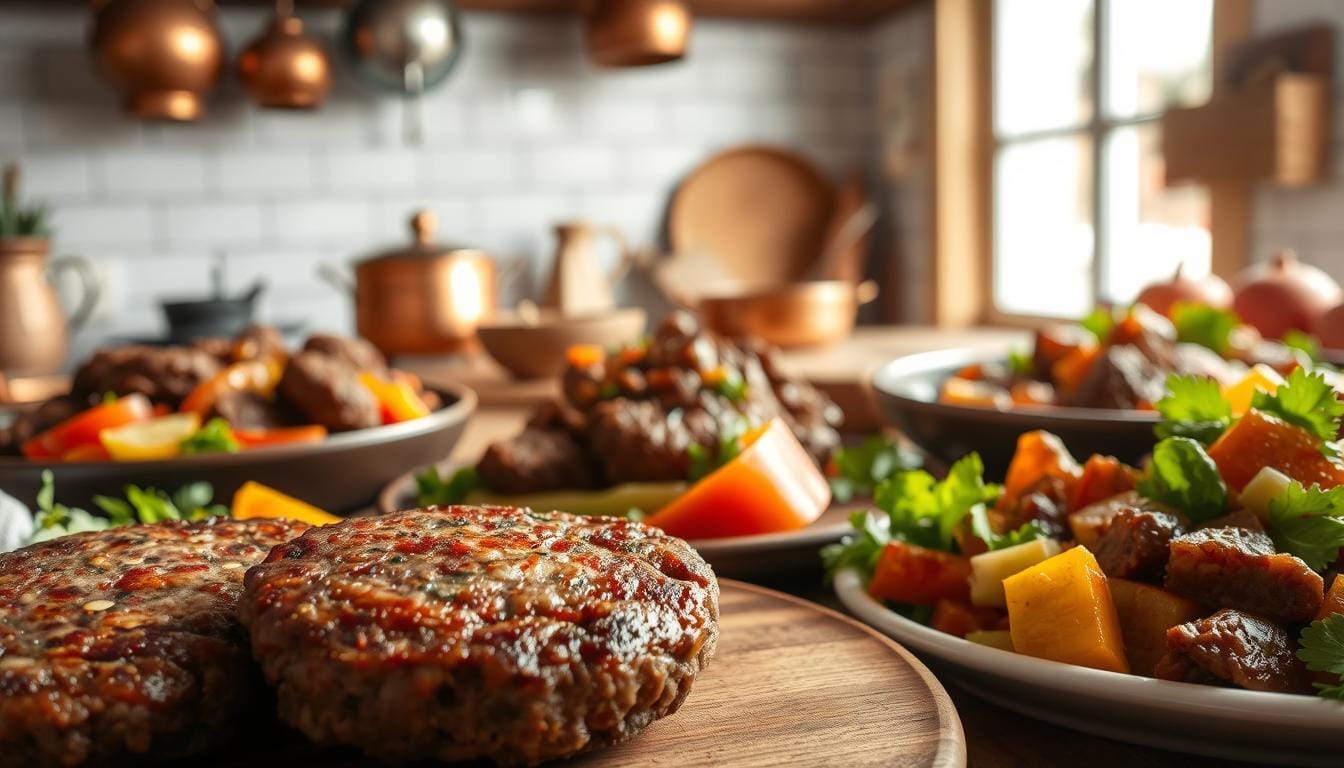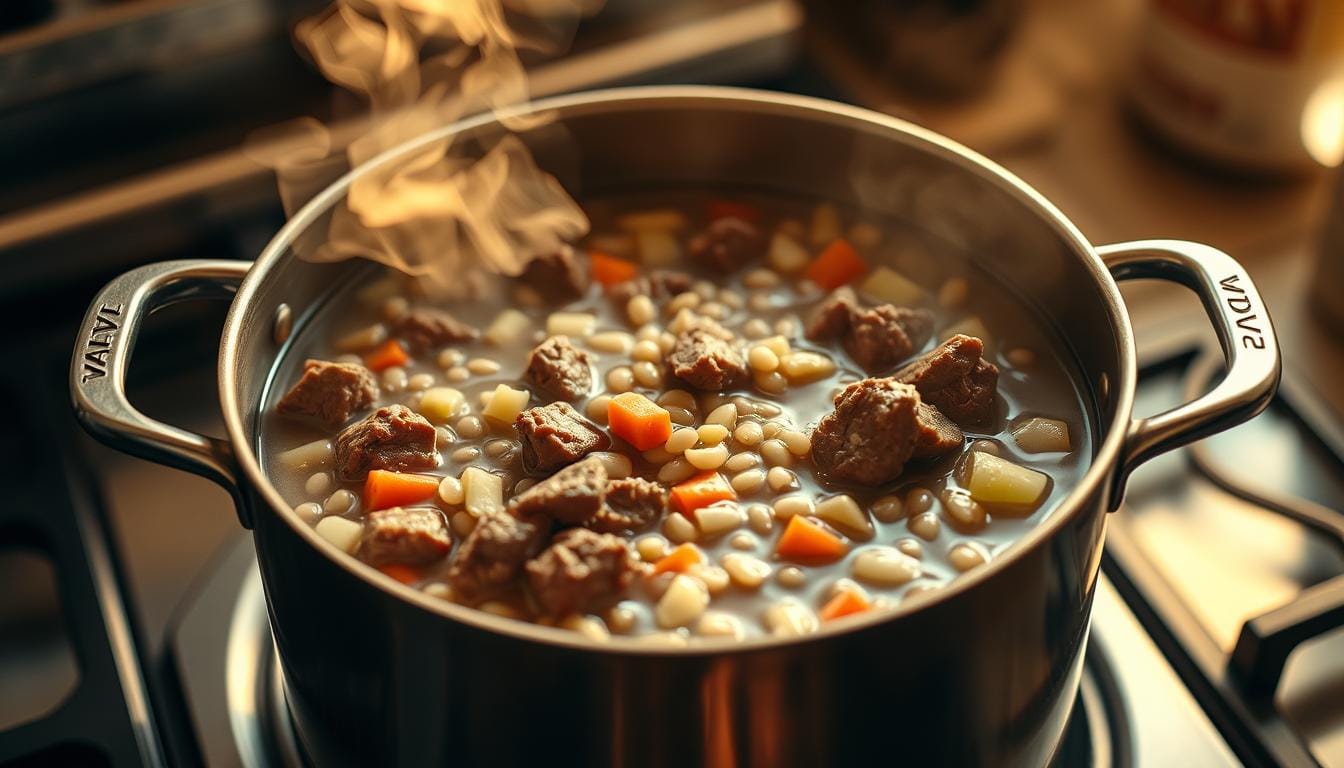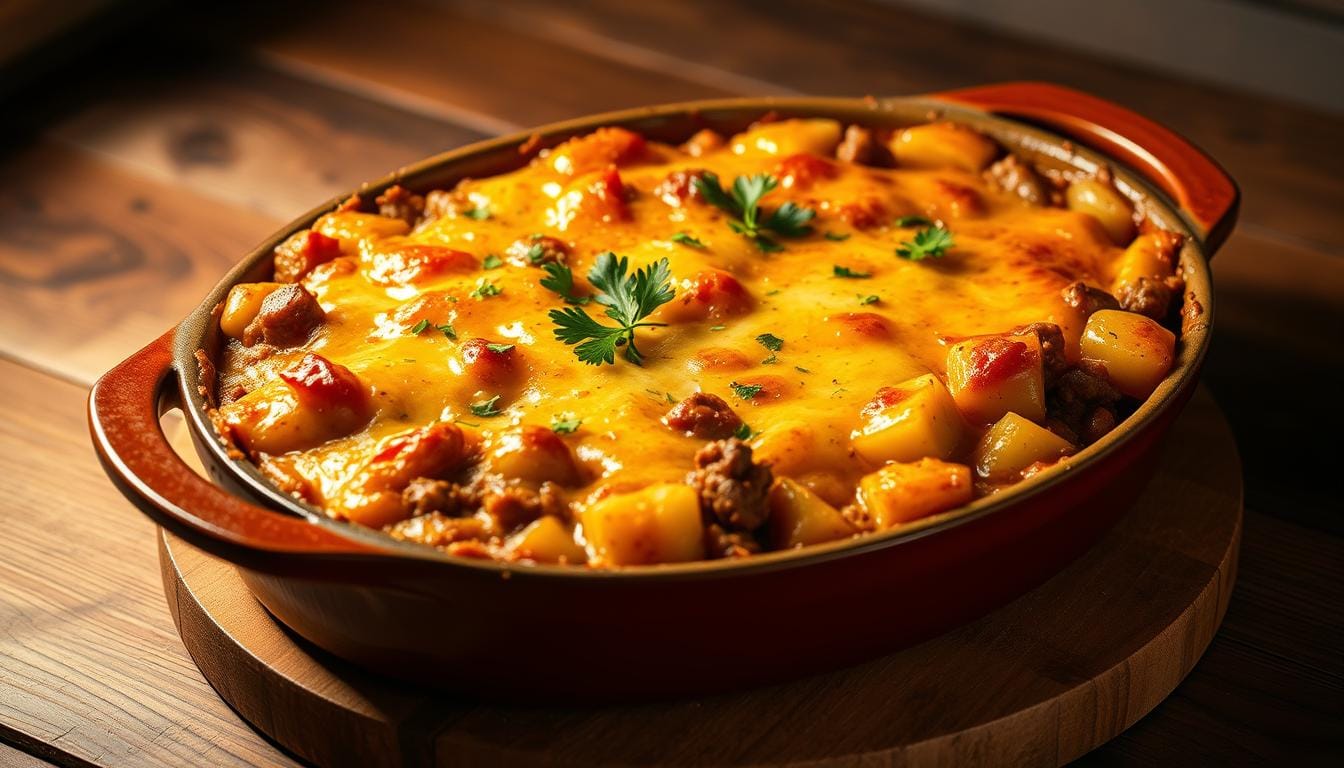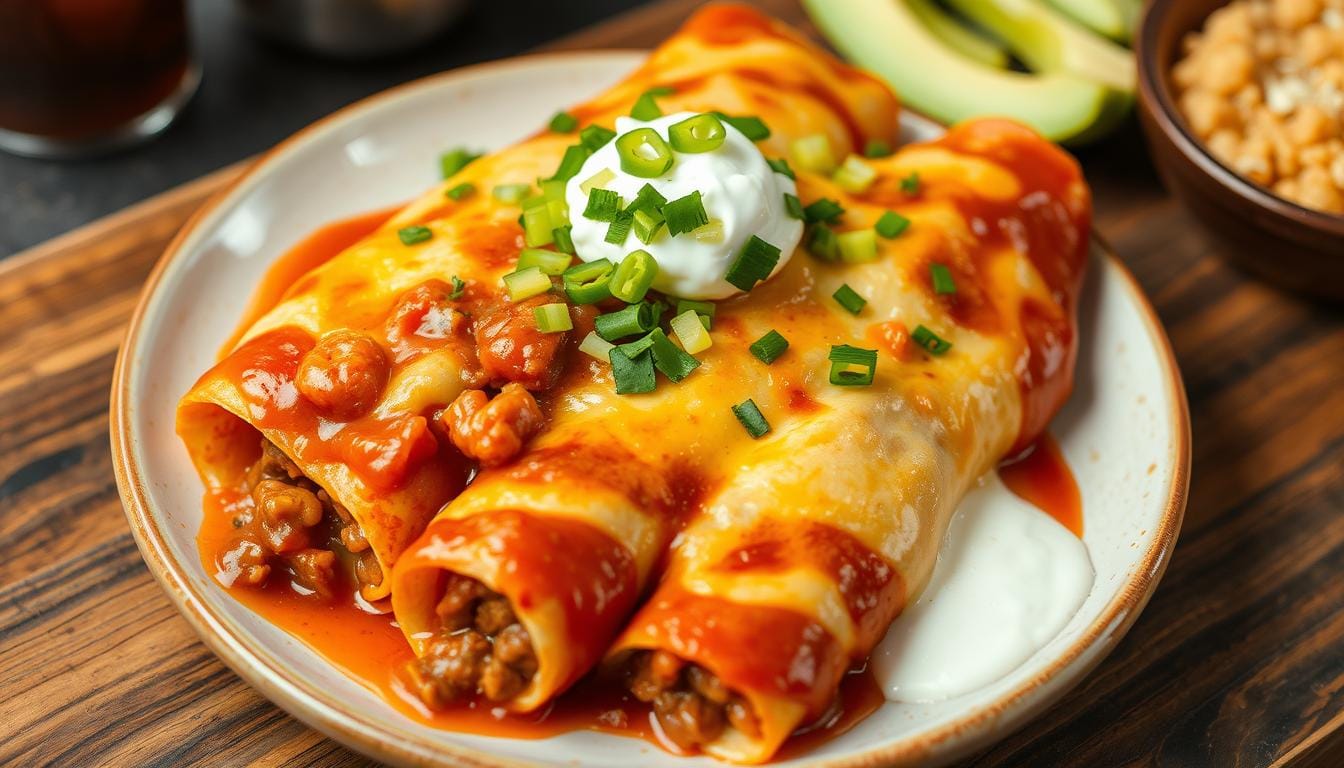The Best Beef Stew Recipe for Your Family Dinner (+Video)
Table of Contents
The Best Beef Stew Recipe for Your Family Dinner
Growing up, my grandmother’s kitchen always smelled of rich, simmering beef stew. It would draw our entire family together. Those memories of warmth, comfort, and connection are why I’m passionate about sharing the best beef stew recipe.
This recipe can turn an ordinary dinner into a memorable family experience. Creating a hearty beef stew is more than cooking a meal. It’s about making moments of joy around your dining table.
Every home cook dreams of perfecting that ultimate comfort food. Beef stew is the pinnacle of hearty, soul-warming cuisine. Whether for a busy weeknight or a weekend gathering, this recipe promises incredible flavor and satisfaction.
Key Takeaways
- Learn the secrets to creating a restaurant-quality beef stew
- Discover techniques for selecting the best ingredients
- Understand how to build layers of flavor in your stew
- Master cooking methods that guarantee tender meat
- Transform family dinners with a classic comfort food
Introduction to Beef Stew
Beef stew is a beloved comfort food in America. It’s more than a meal; it’s a tradition that warms hearts and souls. Each spoonful brings joy and comfort.
What Makes Beef Stew Special?
Beef stew turns simple ingredients into a flavorful feast. It’s all about slow cooking, making tough meat tender and delicious. It’s the ultimate comfort food, offering:
- Rich, deep flavors that develop over time
- Nutritious combination of protein and vegetables
- A one-pot meal that feeds the entire family
- Warm, nostalgic memories of home-cooked meals
History of Beef Stew in American Cuisine
Beef stew’s history comes from European immigrants. They brought recipes that used minimal ingredients for maximum flavor. Immigrant families adapted their traditional stews to use American ingredients, creating unique regional flavors.
From cowboy chuck wagons to today’s kitchens, beef stew remains a favorite. Its simplicity and versatility have made it a staple in American cooking. It connects us to our cultural heritage through delicious meals.
Essential Ingredients for Beef Stew
Starting a delicious beef stew means picking the right ingredients. Your journey begins with knowing how each part adds to a hearty meal. This meal will warm your family’s hearts and fill their bellies.
Choosing the Right Cut of Beef
The beef chuck roast is the top pick for a tasty stew. It comes from the cow’s shoulder and is full of flavor and tenderness. Its marbling makes the savory broth rich and delicious.
- Look for beef chuck roast with good marbling
- Select cuts around 2-3 pounds for optimal stew preparation
- Trim excess fat before cooking for better texture
Fresh Vegetables to Include
Vegetables turn your beef stew into a full meal. The right mix adds color, texture, and nutrients.
- Carrots: Sweet and hearty
- Potatoes: Provides substance and thickness
- Onions: Adds depth of flavor
- Celery: Brings subtle background notes
Herbs and Spices for Flavor
Herbs and spices make your stew go from good to great. Fresh ingredients give the best taste.
- Thyme: Earthy and warm
- Rosemary: Aromatic and pine-like
- Bay leaves: Subtle complexity
- Black pepper: Sharp and pungent
Choosing each ingredient with care makes a stew that’s not just filling. It’s also a meal that creates lasting memories for your family.
Tools You’ll Need for Cooking
Preparing a delicious cozy winter meal needs the right kitchen tools. The right tools can make your cooking better and ensure your slow cooker beef stew is perfect every time.
Having the essential utensils makes stew preparation smooth and fun. The right tools can greatly improve your dish’s quality and taste.
Essential Kitchen Utensils
- Sharp chef’s knife for precise vegetable chopping
- Cutting board with non-slip surface
- Sturdy wooden spoon for stirring
- Large mixing bowl for ingredient preparation
- Measuring cups and spoons for accurate ingredient portioning
Recommended Cookware for Optimal Results
Choosing the right cookware can make your cozy winter meal outstanding. Different cooking methods need specific equipment for the best results.
- Slow Cooker: Perfect for hands-off, tender beef stew preparation
- Heavy-bottomed Dutch oven for even heat distribution
- Cast iron skillet for initial meat searing
- Stainless steel or enameled pot with tight-fitting lid
Investing in quality kitchen tools makes cooking your slow cooker beef stew easier and more fun. Remember, great cooking starts with the right equipment!
Step-by-Step Guide to Making Beef Stew

Making a tasty braised beef stew needs careful steps. This guide will show you how to make a hearty stew. It will warm your family’s hearts and please their taste buds.
Prepping Your Ingredients
Good stew starts with the right ingredients. First, gather everything you need before you cook. Here’s a quick list for your stew:
- Trim excess fat from beef chunks
- Chop vegetables into uniform sizes
- Measure out spices and herbs
- Pat meat dry with paper towels
Browning the Meat Perfectly
Browning meat is key for deep flavors in your stew. Use a heavy-bottomed pan and follow these steps:
- Heat oil until it’s slightly smoking
- Add meat in small batches
- Avoid overcrowding the pan
- Brown each side for 2-3 minutes
Combining Ingredients for Flavor
The secret to a great stew is layering flavors. Start by sautéing onions and garlic. Then, deglaze the pan with red wine or beef broth. Add your browned meat, vegetables, and herbs for a rich taste.
Pro tip: Let your stew simmer slowly. This tenderizes the meat and blends all the flavors.
Cooking Techniques
Creating a tasty slow cooker beef stew needs you to know about different cooking ways. Each method has its own benefits for making the perfect comfort food. Your choice of cooking method can greatly affect the stew’s flavor, texture, and quality.
Stovetop Method: Traditional Slow Cooking
The stovetop method is a classic way to make beef stew. It lets you control the cooking closely. You should:
- Brown meat in a heavy-bottomed pot
- Develop deep flavor through direct heat
- Simmer ingredients slowly for tender results
Slow Cooker Method: Ultimate Convenience
A slow cooker is perfect for the best beef stew recipe with little effort. Ideal for busy home cooks, it lets you prep in the morning and come home to a ready meal. Your slow cooker beef stew will simmer all day, making flavors rich and deep.
Instant Pot: Quick and Efficient Cooking
If you’re short on time, the Instant Pot is quick. It can turn tough meat into tender, flavorful stew in under an hour. Its benefits include:
- Rapid cooking times
- Sealed environment preserves moisture
- One-pot convenience
Choosing the right cooking method depends on your schedule, kitchen tools, and what you like. Each way can make a delicious beef stew that will warm your family’s hearts.
Tips for Perfecting Your Beef Stew
Making a delicious beef stew is more than just mixing ingredients. Professional chefs use special techniques to make their stew stand out. These techniques make the savory beef broth truly special.
To make your beef stew a true masterpiece, you need to know some key cooking strategies. These strategies improve the flavor, texture, and enjoyment of your dish.
Importance of Searing the Meat
Searing meat is a key step in making your stew taste rich and deep. When you sear meat at high heat, you create Maillard reactions. These reactions make your stew taste complex and amazing. Here are some tips for searing meat:
- Pat meat dry before searing to ensure proper browning
- Use a heavy-bottomed pan with high heat
- Avoid overcrowding the pan to achieve optimal caramelization
- Sear meat in batches for consistent results
Balancing Flavors with Acid
A great savory beef broth needs balanced acidity to cut through the richness of the meat. Acidic ingredients make your stew taste brighter:
- Red wine vinegar
- Tomato paste
- Worcestershire sauce
- Balsamic vinegar
Thickening Your Stew: Techniques and Tips
Getting the right consistency is crucial for a great beef stew. Here are some ways to thicken your stew:
- Coat meat in flour before browning
- Use cornstarch slurry
- Puree some vegetables into the broth
- Reduce liquid by simmering uncovered
By using these professional techniques, you can turn your beef stew into a memorable meal. It will impress your family and friends.
Serving Suggestions
Turning your beef stew into a cozy winter meal is all about the sides. The right choices can make your comfort food a feast for all senses.
Choosing the perfect sides for your beef stew can make it special. Here are some tasty options:
- Crusty Bread: Artisan sourdough or rustic French bread for soaking up rich gravy
- Garlic mashed potatoes for additional warmth
- Roasted root vegetables for complementary textures
- Fresh green salad with tangy vinaigrette
Perfect Bread Pairings
Bread is key to a great cozy winter meal. Warm, crusty bread soaks up the stew’s flavors. It also adds a nice texture to your comfort food.
Salad Selections to Balance Your Meal
A crisp salad can balance the richness of beef stew. Try a simple mixed greens salad with a light, acidic dressing. It refreshes your taste buds between bites.
By picking the right sides, you’ll make your beef stew dinner unforgettable. It becomes a special family meal.
Storing and Reheating Leftovers

Your delicious hearty beef stew doesn’t have to end after one night. With the right storage and reheating, you can enjoy it for days. This way, you keep its amazing flavor and texture.
Refrigeration Best Practices
Storing your beef stew right is key for safety and taste. Here’s how to keep it fresh:
- Cool the stew completely before storing
- Use airtight containers to prevent contamination
- Refrigerate within two hours of cooking
- Store in the refrigerator for 3-4 days maximum
Expert Reheating Methods
To keep your stew’s rich flavor, try these reheating methods:
- Stovetop Method: Gently reheat in a pot over low heat, stirring occasionally
- Oven Technique: Warm in an oven-safe dish at 325°F, covered with foil
- Microwave Option: Use medium power and stir every 30 seconds
Pro tip: Add a splash of broth when reheating. This keeps the stew moist and flavorful.
Variations of Beef Stew Recipes
Exploring beef stew opens up a world of flavors. Every kitchen can turn this dish into something special. It’s all about mixing old ways with new ideas.
Beef stew is incredibly versatile. Classic beef bourguignon shows how different cultures can make a simple dish great.
Classic vs. Modern Takes
Traditional beef stew recipes use old techniques. But, modern versions add exciting twists:
- Incorporate global spices like garam masala or harissa
- Use alternative protein sources like lamb or venison
- Experiment with plant-based meat substitutes
- Add unexpected ingredients like chocolate or coffee
International Inspirations for Unique Flavors
Different cultures bring their own twist to beef stew:
- Hungarian Goulash: Paprika-rich beef stew
- Irish Guinness Stew: Beer-infused hearty dish
- Korean Beef Stew: Soy and ginger-based variation
- Moroccan Tagine: Slow-cooked stew with aromatic spices
Your journey with beef stew is endless. Don’t be afraid to try new things. Make a dish that shows off your taste and creativity.
Common Mistakes to Avoid
Making the perfect braised beef stew is more than just throwing ingredients together. Even skilled cooks can fall into common traps that ruin the dish. These mistakes can affect the quality of your savory beef broth and the whole meal.
Knowing these mistakes can turn your beef stew into something truly special. Let’s look at the main errors that can mess up your cooking.
Overcrowding Your Cooking Pot
One big mistake is putting too much meat in the pot. When there’s too much, the meat steams instead of sears. This means it misses out on developing those deep, rich flavors that make a great savory beef broth.
- Leave space between meat pieces
- Cook in batches if necessary
- Ensure each piece has direct contact with the hot surface
Skipping the Crucial Searing Step
Searing meat is not just an extra step—it’s essential for flavor. Skipping this step means missing out on the Maillard reaction. This reaction creates complex flavors that make your stew stand out.
- Pat meat dry before searing
- Use high heat
- Allow meat to develop a golden-brown crust
By avoiding these mistakes, you’ll make a braised beef stew full of flavor. It’s sure to wow your dinner guests.
Conclusion: Enjoying Your Beef Stew
Beef stew is more than a meal; it’s a special experience that makes your kitchen warm and welcoming. It’s a comfort food that brings families together with its delicious flavors and inviting smell. Making your own beef stew can create memories that last a lifetime.
Every time you make stew, you can try something new. You can make it spicier or add local ingredients. Beef stew is like a blank canvas for your cooking, letting you try new things each time.
Making Family Memories Over Dinner
Having beef stew together is a tradition that connects families. Let everyone help in the kitchen, teaching them how to cook and sharing stories. These moments make the meal as nourishing as the food itself.
Encouragement to Experiment and Customize
Your beef stew journey is just starting. Each time you cook, you’ll learn new things and find new flavors. Let your creativity shine as you cook, making your stew truly special.
FAQ
What is the best cut of beef for stew?
Beef chuck roast is the top choice for stew. It’s full of marbling, gets tender with slow cooking, and tastes rich. Look for meat with lots of marbling for a savory stew.
Can I make beef stew in a slow cooker?
Yes, a slow cooker is great for beef stew. It makes the meat tender and the flavors deep. Brown the meat first, then cook it in the slow cooker with veggies and broth. Cook on low for 7-8 hours for the best taste.
How can I thicken my beef stew?
You can thicken stew in several ways. Use a roux, cornstarch slurry, potato starch, or puree veggies. Or, just let it simmer uncovered to thicken naturally.
How long can I store beef stew in the refrigerator?
Beef stew can last 3-4 days in the fridge if stored right. Cool it down first, then reheat well before eating. For best taste, eat within 3 days.
Can I freeze beef stew?
Yes, beef stew freezes well. Store it in airtight containers or bags. It keeps for up to 3 months. Thaw it in the fridge and reheat gently.
What are the best vegetables to include in beef stew?
Use potatoes, carrots, and onions for a classic stew. Add celery, parsnips, or turnips for more flavor and nutrients. Pick veggies that stay firm during cooking.
How do I prevent meat from becoming tough in beef stew?
Choose the right cut, like chuck roast, and cut it evenly. Brown it first, then cook it low and slow. Avoid boiling and simmer gently for tender meat.
What herbs work best in beef stew?
Thyme, rosemary, and bay leaves are traditional herbs for stew. Fresh herbs add brightness, while dried ones offer deep flavor. Add parsley as a garnish for a fresh taste.

